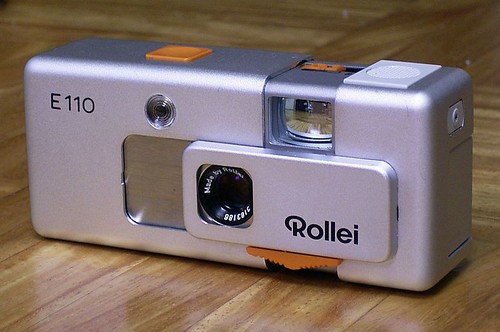Difference between revisions of "Rollei E110"
m (ps to cw pool, updated img temp) |
m (Layout tidy up.) |
||
| (One intermediate revision by one other user not shown) | |||
| Line 7: | Line 7: | ||
|image_rights=cc | |image_rights=cc | ||
}} | }} | ||
| − | + | {{Flickr_image | |
| + | |image_source= http://www.flickr.com/photos/26092923@N02/2596070687/in/pool-camerawiki/ | ||
| + | |image= http://farm4.static.flickr.com/3012/2596070687_1aaf17c7b5.jpg | ||
| + | |image_align= left | ||
| + | |image_text= E110 with Flashcube attachment | ||
| + | |image_by= Jack Hufnagel | ||
| + | |image_rights= with permission | ||
| + | }} | ||
{{br}} | {{br}} | ||
The '''Rollei E110''' is the "budget" version of the '''[[Rollei A110]]'''. | The '''Rollei E110''' is the "budget" version of the '''[[Rollei A110]]'''. | ||
| Line 15: | Line 22: | ||
The viewfinder is a bright frame eye-level unit with a magnification of .6x, with indicators for distance (combined meter/feet symbol scale), normal/long time exposure (green [[LED]] for speeds 1/30th or faster, no LED for longer speeds), shutter release, and battery check. | The viewfinder is a bright frame eye-level unit with a magnification of .6x, with indicators for distance (combined meter/feet symbol scale), normal/long time exposure (green [[LED]] for speeds 1/30th or faster, no LED for longer speeds), shutter release, and battery check. | ||
| − | |||
| − | |||
| − | |||
| − | |||
| − | |||
| − | |||
| − | |||
| − | |||
Attaching the diminutive [[flashcube]] holder, which bayonets onto the camera's right side, engages a coupling between the focusing and aperture mechanisms that provides flash exposure automation. | Attaching the diminutive [[flashcube]] holder, which bayonets onto the camera's right side, engages a coupling between the focusing and aperture mechanisms that provides flash exposure automation. | ||
While the small 110 film format does in general limit the camera's performance, in the right hands and with suitable film such as Verichrome Pan, the Rollei E110 was capable of making very good 5x7 prints and passable 8x10s. | While the small 110 film format does in general limit the camera's performance, in the right hands and with suitable film such as Verichrome Pan, the Rollei E110 was capable of making very good 5x7 prints and passable 8x10s. | ||
| − | + | ==Specifications== | |
| − | |||
| − | |||
| − | == | ||
*Type: pocket camera | *Type: pocket camera | ||
*Manufacturer: [[Rollei]] | *Manufacturer: [[Rollei]] | ||
| Line 45: | Line 41: | ||
[[Category: German 110 film]] | [[Category: German 110 film]] | ||
| − | [[Category: Rollei]] | + | [[Category: Rollei|E110]] |
[[Category: Singapore]] | [[Category: Singapore]] | ||
[[Category: R]] | [[Category: R]] | ||
[[Category: E|E110]] | [[Category: E|E110]] | ||
Latest revision as of 10:18, 7 May 2017

|
| E110 pocket camera made by Rollei image by ja1vbn (Image rights) |

|
| E110 with Flashcube attachment image by Jack Hufnagel (Image rights) |
The Rollei E110 is the "budget" version of the Rollei A110.
The major differences between the two is a simplified exposure system. The E110 utilizes a CdS photocell whereas the A110 has a silicon photocell. On the E110, one sets the lens aperture at f/2.8, 5.6, or 16 via an orange slide accessible on the top of the camera when it is open. The camera's exposure system then sets the shutter speed. On the A110, the camera sets both the aperture and shutter. Thus, the less expensive version of Rollei's 110 cameras actually offers the photographer more flexibility.
The viewfinder is a bright frame eye-level unit with a magnification of .6x, with indicators for distance (combined meter/feet symbol scale), normal/long time exposure (green LED for speeds 1/30th or faster, no LED for longer speeds), shutter release, and battery check.
Attaching the diminutive flashcube holder, which bayonets onto the camera's right side, engages a coupling between the focusing and aperture mechanisms that provides flash exposure automation.
While the small 110 film format does in general limit the camera's performance, in the right hands and with suitable film such as Verichrome Pan, the Rollei E110 was capable of making very good 5x7 prints and passable 8x10s.
Specifications
- Type: pocket camera
- Manufacturer: Rollei
- Film: Type 110 cartridges for 16mm film (13x17mm image) with speeds of 100 or 400 ASA selected by film cartridge notch
- Lens: Rollei Tessar f=23mm f/2.8 - f/16 (focusing 1 meter to infinity)
- Shutter: electronically controlled Rollei-Prontor leaf shutter (continuous speeds from 4 - 1/250 sec.)
- Exposure: CdS photo-resistor measures light for aperture-priority automatic exposure (manually set aperture)
- Dimensions: 84×44×30mm (closed, length 100 mm when opened)
- Weight: 185 g / 6½ oz. with battery